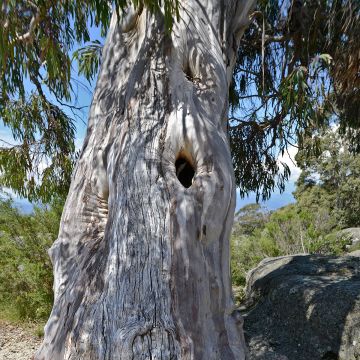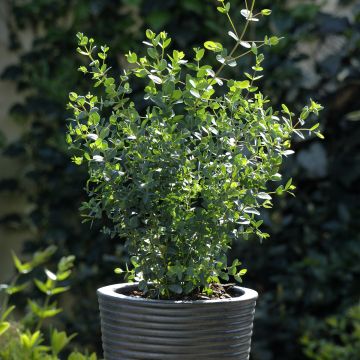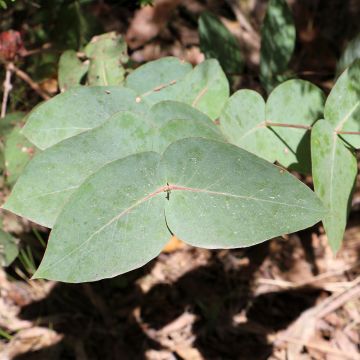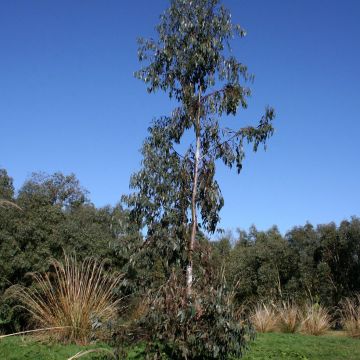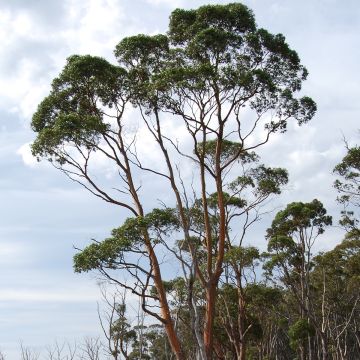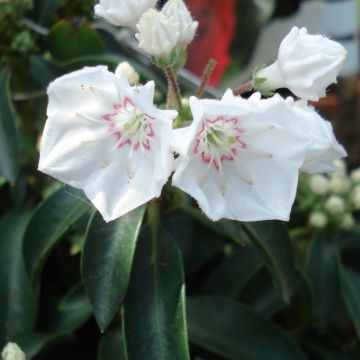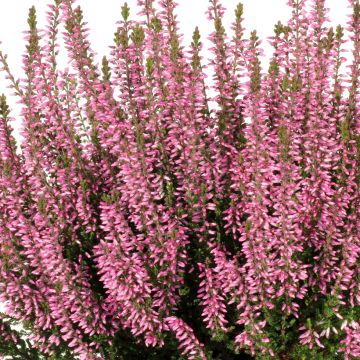

Eucalyptus cordata subsp quadrangulosa
Eucalyptus cordata subsp quadrangulosa
Eucalyptus cordata subsp quadrangulosa
heart-leaved Gum tree
This item cannot be shipped to the selected country
Delivery charge from €5.90
More information
Schedule delivery date,
and select date in basket
This plant carries a 24 months recovery warranty
More information
We guarantee the quality of our plants for a full growing cycle, and will replace at our expense any plant that fails to recover under normal climatic and planting conditions.
From €5.90 for pickup delivery and €6.90 for home delivery
Express home delivery from €8.90.
Does this plant fit my garden?
Set up your Plantfit profile →
Description
Eucalyptus cordata subsp quadrangulosa is a Heart-leaved Gum, with heart-shaped or rounded leaves. While eucalyptus often have juvenile foliage of this shape, it rarely persists to maturity. In the Eucalyptus cordata, this shape is always present on the majority of the adult crown. The term quadrangulosa refers to its square-section stems, it is a subspecies that can form much larger trees in its native area in Australia. This Eucalyptus makes a very good windbreak, especially in coastal gardens, thanks to its upright, pyramidal and bushy habit, where all its lower branches remain. It is very tolerant to sea spray. Its smooth bark is marbled with green, white and grey tones. Its spring flowering in white pompoms is relatively abundant. Hardy down to about -10 to -15° (14 to 5 °F) C, it tolerates opposite climate conditions: humidity as well as drought and clay or dry soils.
Eucalyptus cordata subsp quadrangulosa or Heart-leaved Gum is a large bush of the myrtaceae family, whose range is limited to the sub-coastal ranges of southeastern Tasmania. This subspecies grows in moist clayey to clay soils. This gum reaches a mature height of 10 m (32 ft 10 in) and a spread of 4 to 5 m (13 ft 1 in to 16 ft 5 in), with rapid growth. The young shoots of this eucalyptus carry evergreen foliage, composed of round to heart-shaped leaves, grey-green or glaucous in colour. Most keep this shape while others lengthen into a more lanceolate shape at adult age. They are slightly aromatic when crumpled. Flowering occurs in late summer under our climates, on plants aged a few years. These are round petal-less flowers, composed of a multitude of tightly packed cream-white stamens like a pompom. They bloom between the leaves, grouped by three all along the shoots and are followed by the formation of large green cone-shaped fruits, becoming brown when ripe. This eucalyptus has a lignotuber just below the surface of the soil. This organ allows it to regrow from the stump in case of severe frost, fire or hard pruning. The plant also produces numerous shoots from dormant buds located under its bark, allowing it to respond well to pollarding and topping.
Eucalyptus cordata subsp quadrangulosa copes very well with pruning and can be grown as a bush 2 m (6 ft 7 in) high or more or it can be left unpruned. It naturally has a narrow habit and very dense foliage, present from bottom to top, which gives it a good quality as a windbreak. Eucalyptus are generally big water consumers, even in winter, contributing to drying out the soil. On the other hand, their resistance to summer drought is proven. Eucalyptus cordata, due to its branching habit, makes a beautiful screen of foliage and works wonders in groves. It brings a touch of exoticism to the garden, planted in a hedge with other relatively hardy bushes such as Buddleia 'Lochinch' and 'Bicolor' or some oleanders (Luteum Plenum, 'Provence', 'Atlas'). But it can also make a beautiful fast-growing tree on its own, very tolerant of extreme conditions.
Report an error about the product description
Eucalyptus cordata subsp quadrangulosa in pictures


Plant habit
Flowering
Foliage
Botanical data
Eucalyptus
cordata subsp quadrangulosa
Myrtaceae
heart-leaved Gum tree
Australia
Other Eucalyptus
Planting and care
Eucalyptus cordata subsp quadrangulosa is best planted at the start of spring in cold regions, at the beginning of autumn in dry and hot climates, in a warm and sunny location. In most regions, you can plant it directly in the soil. Then let nature take its course, the growth is fairly rapid. Regularly water for the first two years, then the bush requires absolutely no watering in summer. Fertiliser is not recommended. There's no need to prune, but the young plant tolerates pruning very well after 3 or 4 years of cultivation. In March, you can cut it back near the soil to form a nice, thick bush of 2-3 m (6 ft 7 in-9 ft 10 in) high. Gum trees are useful for drying out damp soils, as they are heavy water consumers even in winter. However, they are resistant to drought once well established and generally do very well in a Mediterranean-type climate.
Planting period
Intended location
Care
This item has not been reviewed yet - be the first to leave a review about it.
Evergreen shrubs
Haven't found what you were looking for?
Hardiness is the lowest winter temperature a plant can endure without suffering serious damage or even dying. However, hardiness is affected by location (a sheltered area, such as a patio), protection (winter cover) and soil type (hardiness is improved by well-drained soil).

Photo Sharing Terms & Conditions
In order to encourage gardeners to interact and share their experiences, Promesse de fleurs offers various media enabling content to be uploaded onto its Site - in particular via the ‘Photo sharing’ module.
The User agrees to refrain from:
- Posting any content that is illegal, prejudicial, insulting, racist, inciteful to hatred, revisionist, contrary to public decency, that infringes on privacy or on the privacy rights of third parties, in particular the publicity rights of persons and goods, intellectual property rights, or the right to privacy.
- Submitting content on behalf of a third party;
- Impersonate the identity of a third party and/or publish any personal information about a third party;
In general, the User undertakes to refrain from any unethical behaviour.
All Content (in particular text, comments, files, images, photos, videos, creative works, etc.), which may be subject to property or intellectual property rights, image or other private rights, shall remain the property of the User, subject to the limited rights granted by the terms of the licence granted by Promesse de fleurs as stated below. Users are at liberty to publish or not to publish such Content on the Site, notably via the ‘Photo Sharing’ facility, and accept that this Content shall be made public and freely accessible, notably on the Internet.
Users further acknowledge, undertake to have ,and guarantee that they hold all necessary rights and permissions to publish such material on the Site, in particular with regard to the legislation in force pertaining to any privacy, property, intellectual property, image, or contractual rights, or rights of any other nature. By publishing such Content on the Site, Users acknowledge accepting full liability as publishers of the Content within the meaning of the law, and grant Promesse de fleurs, free of charge, an inclusive, worldwide licence for the said Content for the entire duration of its publication, including all reproduction, representation, up/downloading, displaying, performing, transmission, and storage rights.
Users also grant permission for their name to be linked to the Content and accept that this link may not always be made available.
By engaging in posting material, Users consent to their Content becoming automatically accessible on the Internet, in particular on other sites and/or blogs and/or web pages of the Promesse de fleurs site, including in particular social pages and the Promesse de fleurs catalogue.
Users may secure the removal of entrusted content free of charge by issuing a simple request via our contact form.
The flowering period indicated on our website applies to countries and regions located in USDA zone 8 (France, the United Kingdom, Ireland, the Netherlands, etc.)
It will vary according to where you live:
- In zones 9 to 10 (Italy, Spain, Greece, etc.), flowering will occur about 2 to 4 weeks earlier.
- In zones 6 to 7 (Germany, Poland, Slovenia, and lower mountainous regions), flowering will be delayed by 2 to 3 weeks.
- In zone 5 (Central Europe, Scandinavia), blooming will be delayed by 3 to 5 weeks.
In temperate climates, pruning of spring-flowering shrubs (forsythia, spireas, etc.) should be done just after flowering.
Pruning of summer-flowering shrubs (Indian Lilac, Perovskia, etc.) can be done in winter or spring.
In cold regions as well as with frost-sensitive plants, avoid pruning too early when severe frosts may still occur.
The planting period indicated on our website applies to countries and regions located in USDA zone 8 (France, United Kingdom, Ireland, Netherlands).
It will vary according to where you live:
- In Mediterranean zones (Marseille, Madrid, Milan, etc.), autumn and winter are the best planting periods.
- In continental zones (Strasbourg, Munich, Vienna, etc.), delay planting by 2 to 3 weeks in spring and bring it forward by 2 to 4 weeks in autumn.
- In mountainous regions (the Alps, Pyrenees, Carpathians, etc.), it is best to plant in late spring (May-June) or late summer (August-September).
The harvesting period indicated on our website applies to countries and regions in USDA zone 8 (France, England, Ireland, the Netherlands).
In colder areas (Scandinavia, Poland, Austria...) fruit and vegetable harvests are likely to be delayed by 3-4 weeks.
In warmer areas (Italy, Spain, Greece, etc.), harvesting will probably take place earlier, depending on weather conditions.
The sowing periods indicated on our website apply to countries and regions within USDA Zone 8 (France, UK, Ireland, Netherlands).
In colder areas (Scandinavia, Poland, Austria...), delay any outdoor sowing by 3-4 weeks, or sow under glass.
In warmer climes (Italy, Spain, Greece, etc.), bring outdoor sowing forward by a few weeks.


































